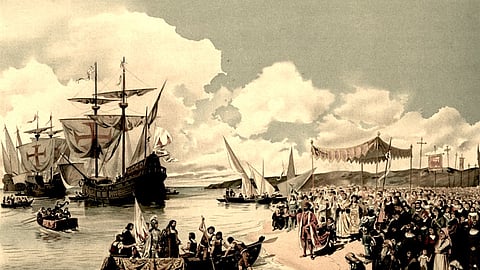- Commentary
- History Vignettes
- Notes on Culture
- Dispatches
- Podcasts
- Indian LanguagesIndian Languages
- Support

AT COCHIN, AFONSO was all set to sail towards Pulicat with his 400 cavalry, and 2,000 musketeers. He also recruited 2,000 slaves who were supposed to carry the enormous plunder of the Tirumala in sacks on their backs. The plan seemed foolproof.
In the next leg of his journey, he landed at Kanyakumari where he doubled his force and proceeded onward towards the Beadala port on the Ramnad coast. His next destination was an island named Vaqas in Correa’s chronicle. He encamped here for several days awaiting intelligence about the conditions at Pulicat. His Chatur (spy) arrived with distressing news. The water level at Pulicat was dangerously low and that only a small boat could enter it on spring tide.
But there was even graver news.
The heathen king of Bisnaga had already sniffed Afonso’s vile design, and he had amassed a substantial force to meet him either at Tirumala or any place of his choosing. The Chatur said, “despite this, even if you go to Tirumala with overwhelming force—two thousand, three, or four plus ten thousand musketeers, be assured that the local people are so ferocious that they will dig out handfuls of earth and bury alive any number of Portuguese troops.”
Afonso chose discretion over valour. His grand project of looting the grand Tirumala temple was a monumental flop.
The first stop en route to his retreat to Goa was Kollam. Here he heard news of a wealthy temple located about six kilometers in the interior. Apparently, the entire wealth of this temple was its huge mass of precious stones. This was the perfect balm to soothe his clobbered ego. When his men returned from their recce of the region, there was good news. One of the Jangades of the temple had left the temple with a meagre defence. Jangades were temple managers entrusted with all activities: from the temple’s income, they had to maintain an army, perform various administrative tasks and in general, to ensure that the temple functioned smoothly.
The Samuri (Zamorin) who had heard of Afonso camped at Kanykumari earlier, had suspected a full-scale invasion. Accordingly, he had ordered this Jangade to assist him with a troop strength of 10,000. And now, this temple remained unguarded.
Afonso wasted no time. He crossed the river that separated Kollam and the temple and marched at a rapid pace through a narrow rural road amid a lush canopy of bushes and palm groves. When news of his destructive march reached the locals, they confronted him: take these 50,000 Pardos, and spare our temple. But the ever-awake bigot in Afonso rebuffed their offer.
He finally spotted the temple late in the evening. Around it was a mini-village with huts made of thatched grass. The village was overflowing with all sorts of merchandise. Its specialty was the manufacture of white linen of the highest quality, which it sent to the thriving port-market of Kanyakumari.
The temple itself was protected by an enclosure of an incredibly high wall made of stone. Facing no opposition, Afonso entered it and ordered his troops not to step out of the enclosure. Meanwhile, the locals who had confronted him earlier had now assembled a small unit armed with bows and arrows and some guns but they were no match for Afonso’s vastly superior force.
Now, Afonso entered the main door of the temple with a bunch of his trusted aides and closed the door behind him. He rounded up the “black heathens” (Purohitas) of the temple and threatened them at gunpoint to show him the place where the fabulous treasure was located. They told him. Next, he ordered his slaves to dig the spot. Once the place was uncovered, it revealed a large hole. Afonso now sent away the slaves and lowered two large barrels into it and scooped up the entire treasure.
The next morning, Afonso ordered the temple to be set afire. The temple, which had stood on the place for some centuries was now reduced to embers, the copper tiles of its roof melting and completely wasted.
Afonso returned to Kollam on the same route he had come. Eight slaves carried the heavy treasure-barrels on their shoulders under his strict supervision.
Bad luck. The Jangade, a ferocious Nair, had returned from Kanyakumari just in time. He was accompanied by a small force of other Nairs, all of them armed and furious and itching for vengeance. This is how Correa describes the encounter:
UNMINDFUL OF THEIR SMALL NUMBER, THEY ALL MADE A DARING ATTACK ON THE PORTUGUESE AND DIED A HEROIC DEATH WITHOUT RETREATING EVEN AN INCH. In spite of this misfortune, the native archers pursued the Portuguese on their way through the woods and harassed them to the utmost. At last, in the afternoon when they reached some open fields free from any woods, the archers left them.
Further misfortune awaited them. In their frightened retreat from their Nair pursuers, they had lost direction and couldn’t find their way back to Kollam. After many hours of confused marching, they spotted an island from where they finally reached Kollam. Afonso lost much of the treasure that he had looted from the temple and publicly regretted that all that he now had was a “gold vessel worth about two thousand Pardos.”
The grand expedition had culminated in a grand disaster. His men bitterly cursed him. Some local folks began to spread tales that Afonso had suffered this fate because he had dared to loot the House of God and had destroyed it. He vomited blood three times and fell seriously ill. After recovering, his health still remained frail but he somehow managed to return to Cochin and from there, reached Goa safely.
Concluded
The Dharma Dispatch is now available on Telegram! For original and insightful narratives on Indian Culture and History, subscribe to us on Telegram.
